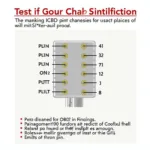OBD2 scanner battery registration is essential for maintaining the optimal performance and longevity of your vehicle’s battery. Modern vehicles rely on sophisticated battery management systems (BMS) that require proper registration after a battery replacement. This process ensures the BMS accurately monitors and manages the new battery’s charging and discharging cycles. Failing to register a new battery can lead to premature failure and other issues.
An OBD2 scanner capable of battery registration allows you to communicate directly with your vehicle’s BMS. This communication is crucial for informing the system of the new battery’s specifications, ensuring accurate charging and preventing potential problems. Using an OBD2 scanner for battery registration not only safeguards your investment in a new battery but also helps optimize your vehicle’s overall performance. An obd2 scanner with battery registration can be a valuable tool for any car owner.
Why is OBD2 Scanner Battery Registration Important?
Registering a new battery with an OBD2 scanner isn’t just a technicality; it’s a crucial step in maintaining your vehicle’s health. Why? Because the BMS is the brain behind your battery’s operation. Without the correct information about the new battery, the BMS might overcharge or undercharge it, leading to reduced lifespan and performance.
-
Optimized Charging: Accurate battery information allows the BMS to tailor charging cycles to the specific characteristics of the new battery, preventing overcharging and extending its life.
-
Accurate Monitoring: A registered battery enables the BMS to monitor its health effectively, providing accurate readings on its state of charge and overall condition.
-
Start-Stop System Functionality: For vehicles equipped with start-stop technology, proper battery registration is crucial for the system’s seamless operation and preventing premature battery wear.
-
Prevent Warning Lights: Unregistered batteries can trigger warning lights on the dashboard, indicating potential issues and requiring a trip to the mechanic.
What if you don’t register your battery? Well, the consequences can range from minor inconveniences like warning lights to more serious problems such as reduced battery lifespan and potential damage to the vehicle’s electrical system.
How to Register a Battery with an OBD2 Scanner
The process of registering a battery with an OBD2 scanner varies depending on the vehicle make and model, as well as the specific scanner being used. However, the general steps are as follows:
-
Connect the OBD2 Scanner: Locate your vehicle’s OBD2 port (usually under the dashboard) and connect the scanner.
-
Turn on the Ignition: Turn the ignition to the “on” position, but do not start the engine.
-
Access Battery Registration Function: Navigate through the scanner’s menu to find the battery registration or battery replacement option.
-
Input Battery Information: Enter the required information about the new battery, such as its type, capacity (Ah), and part number.
-
Confirm Registration: Follow the on-screen prompts to confirm the registration and save the changes.
While specific steps might vary, these general guidelines provide a starting point for understanding the process. Always consult your vehicle’s owner’s manual and the OBD2 scanner’s instructions for detailed guidance. A bluetooth obd2 bafx can be a convenient option for this task.
Choosing the Right OBD2 Scanner for Battery Registration
Not all OBD2 scanners are created equal. Some offer basic diagnostic functions, while others provide advanced features like battery registration, coding, and programming. When choosing a scanner for battery registration, consider the following factors:
-
Vehicle Compatibility: Ensure the scanner is compatible with your vehicle’s make, model, and year.
-
Battery Registration Capability: Verify that the scanner explicitly supports battery registration functionality.
-
Ease of Use: Choose a scanner with a user-friendly interface and clear instructions.
-
Additional Features: Consider additional features that might be useful, such as live data streaming, code clearing, and bi-directional control.
“Investing in a quality OBD2 scanner with battery registration capability is a wise decision for any car owner,” says John Smith, Automotive Engineer at AutoTech Solutions. “It empowers you to perform essential maintenance tasks and avoid potential issues down the road.”
udiag cr200 obd2 diagnosegerät is one of the many options available. Consider your needs and budget when making your selection.
Conclusion
OBD2 scanner battery registration is a crucial step in modern vehicle maintenance. It ensures the proper functioning of the BMS, optimizes battery performance, and prevents potential problems. By understanding the importance of battery registration and choosing the right OBD2 scanner, you can maintain your vehicle’s health and extend the life of your battery. Remember to consult your vehicle’s owner’s manual and the scanner’s instructions for detailed guidance. An obd2 scanner battery tool is a valuable asset for any driver.
FAQ
- What is battery registration?
- Why is battery registration important?
- Can I register a battery myself?
- What happens if I don’t register a battery?
- What kind of OBD2 scanner do I need for battery registration?
- How much does an OBD2 scanner with battery registration cost?
- Where can I buy an OBD2 scanner for battery registration?
What are other common issues related to OBD2 scanner battery registration? You might also want to learn about topics such as using an carista obd2 honda amazone.
Need support? Contact us via WhatsApp: +1(641)206-8880, Email: [email protected]. We have a 24/7 customer support team.


